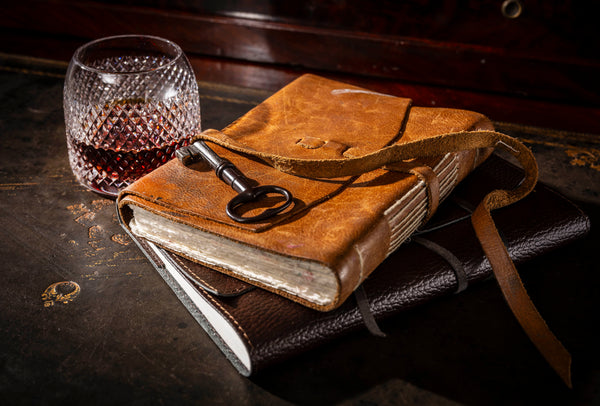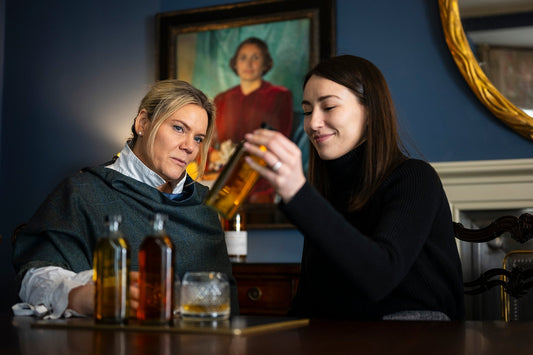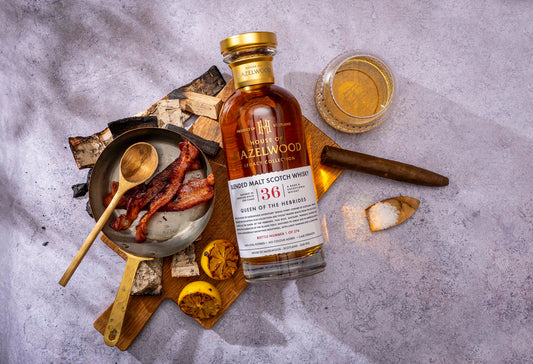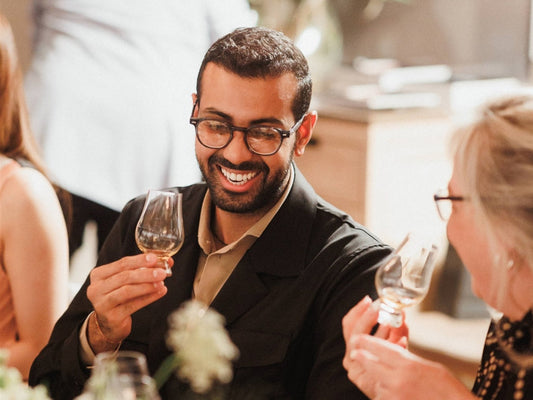How did a whisky destined for mainstream blend become the definition of a liquid time capsule? Writer, Tom Bruce Gardyne, explores the circumstances which led to the creation of one of the rarest offerings from the House of Hazelwood, Blended at Birth.
The original Scotch whisky from a pot still was obviously a single malt – not that it was called that, it was just ‘whisky’. The invention of the patent still in the 1820’s gave us grain whisky which within a generation was being blended with malt whisky. Traditionally the blend was always put together prior to bottling after the component parts had matured.
But the Gordon family were not bound by tradition, and probably around the time they built the Girvan grain distillery in Ayrshire in 1963, it was decided to blend new make grain and malt spirit fresh from the still. For a whisky with a set recipe, it made sense. Instead of having to hunt down casks in the warehouse years later, you could have them all racked up and ready to go.
Jonathan Gibson, House of Hazelwood’s director, imagines the thinking would have been:
“How do you take a process that’s probably not changed a huge amount since the 1930s, and make it more logical and more efficient, and maybe improve the quality and consistency of the product. From my understanding, it wasn’t a common practice.” The family is believed to have continued the practice “through the 1970s and possibly into the very early 1980s.”
Years later, the practice was effectively banned following the redrafting of the Scotch whisky regulations in 2009. It was likely an unintended consequence of the new wording which laid out the rules on single malts and grain whiskies including their minimum ageing requirements, before defining what blended whisky should be. It meant you had to wait three years until you could blend anything.

From Mainstream Blend to Rare Whisky
Jonathan reckons the practice of blending newmake spirit was dreamt up with the US in mind in the era of Mad Men and ‘the three Martini lunch’. Post-war America was thirsty for Scotch and Charlie Gordon, a director of the family business and a great-grandson of the founder, was happy to oblige. It seems these whiskies were often sold as youngish blends to customers that wanted their own proprietary Scotch – anyone from a chain of liquor stores to a local sports club.
Most of it was drunk decades ago, but not all. The Gordon family has always been good at holding back a number of casks of whatever it distilled just to see how they would evolve. That number inevitably shrinks as the casks are sampled and only the best are retained. This process of natural selection, or survival of the fittest, brings us to House of Hazelwood’s ‘Blended at Birth’, a unique bottling of a whisky distilled in 1965.
It demonstrates the slow magic that can sometimes develop between whisky and wood if you have the patience to wait and the ability to recognise the whisky’s potential. In that sense it’s a tribute to the skills of all those within the business who nosed the spirit over the years. The casks involved could so easily have been emptied after three or four years, and their contents dispatched down the bottling line, shipped across the Atlantic and knocked back as Scotch on the rocks.
Yet there was clearly something special about this small parcel of American oak refill barrels, for each time they were nosed it was decided to keep them back a little longer. The whisky was just getting better and better. After 56 years in wood the vast majority has been lost to the Angel’s share, leaving just 192 bottles in total. “I think the nose is very unusual, with quite a nutty aspect of almonds and marzipan,” says Jonathan, and when I tasted it that rich nuttiness really came through on the tongue. It gradually fades to something more herbal and exotic, with a hint of menthol and that lingering note of marzipan.
Blended at Birth may have begun life as a humble, mainstream blend, but it has blossomed into a fascinating whisky, and one that fits the whole ethos of Hazelwood. “We’re very much liquid-led,” says Jonathan. “We’re not about chasing big headline age-statements like the classic 50-year-old single malt. We want the whiskies we release to have a real sense of variation in style and variation in stories.”
It is not something you could recreate today which makes you wonder what other once permitted now prescribed whiskies might exist. To give just one example, up until 1990 distillers were allowed to reinvigorate tired sherry butts with a cupful of paxarette – a rich, treacle-like version of sherry with a flavour of caramelised raisins. If any such casks are lurking in the Gordon family warehouses, there will be a few lovers of old sherried whiskies drooling at the prospect.




